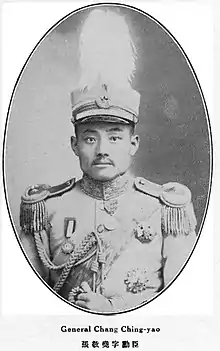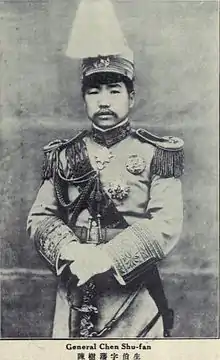| The Anhui Clique | |
|---|---|
| 皖系 Wǎn Xì | |
| Active | 1916–1920 |
| Disbanded | 1920 |
| Country | |
| Allegiance | Beiyang government |
| Type | Warlord faction |
| Size | 40,000–100,000 (Estimate) |
| Engagements | Zhili–Anhui War Occupation of Mongolia |
| Commanders | |
| Premier | Duan Qirui |
| General | Xu Shuzheng |
The Anhui clique (Chinese: 皖系; pinyin: Wǎn Xì) was a military and political organization, one of several mutually hostile cliques or factions that split from the Beiyang clique in the Republic of China's Warlord Era. It was named after Anhui province because several of its generals–including its founder, Duan Qirui–were born in Anhui.[1]
The clique's main members were Duan Qirui, Duan Zhigui, Jin Yunpeng, Wang Yitang, Lu Yongxiang, Zhang Jingyao, Wu Guangxin, Chen Shufan, Zheng Shiqi, Xu Shuzheng, etc.
The Anhui Clique primarily saw their main base of support around the Anhui Province and the Beiyang Government
Because the Anhui clique organized itself very early, it was more politically sophisticated than its warlord rivals.
The Anhui clique had an uneasy co-existence with the Zhili clique and Fengtian clique in the politics of the Beiyang government, often finding itself at odds with the two cliques.
History
During the National Protection War (1915-1916) Duan Qirui gave his support to the Kuomintang revolutionaries against Yuan Shikai
In 1916 after the death of Yuan Shikai and ending of the Constitutional Protection War Premier Duan Qirui would become Premier of the Republic, with Li Yuanhong serving as the President of the Republic, Li Yuanhong acted as a puppet of Duan Qirui due to him being easily manipulated essentially giving the Anhui Clique almost complete control over the Beiyang Government.
With Japanese support and the suppression of the Manchu Restoration in 1917, the Anhui clique became the most powerful faction in China from 1916 to 1920.
The Anhui clique advocated for a hardline approach during the Constitutional Protection War, giving the revolutionaries his political support as Duan Qirui sought to become the President of the Republic.
After the death of Yuan Shikai and his abdication of the Hongxiang Emperor the Beiyang government was restored to which Duan Qirui served as premier under the presidency of Li Yuanhong; Effectively giving Duan Qirui the leadership of China by controlling the weak President, the Clique would only rise in terms of power until 1920.
In 1919 the May Fourth Movement weakened their influence and eventually led to the Zhili–Anhui War in 1920 which saw the surprise defeat of the Anhui clique.[2]
In 1920 Duan Qirui resigned and the clique lacked national leadership for the next four years when all their provinces were eventually annexed by the Zhili clique by the summer of 1924. (Shandong was an anomaly, the Zhili clique appointed an Anhui general in 1923 there provided he remain neutral, see Shandong Problem. Zheng Shiqi ruled until 1925 when he transferred it to Fengtian's Zhang Zongchang per agreement with Duan.)[1]
After the Beijing Coup, Feng Yuxiang and Zhang Zuolin picked Duan to lead a provisional government. Lacking any significant military power, he and his few remaining supporters played Feng and Zhang against each other, they removed him from power and his last followers joined the Fengtian clique.[2][1]
Political wing
The Anhui clique also had a political wing known as the Anfu Club (literally, Peace and Happiness Club, after a Beijing lane where they met; folk etymology claims it was a pun on Anhui and Fujian) which consisted of politicians that threw their fortune in with Duan.
Formed on the 7th of March 1918 by Xu Shuzheng and Wang Yitang, it ran for elections for the northern National Assembly and won three-fourths of the seats primarily because Anhui warlords bought the votes.
The Anfu Club was a highly disciplined party created to push Duan Qirui's agenda through legal means such as electing fellow party member Xu Shichang as President of the ROC.
Before the Zhili–Anhui War, it was also supported by the Fengtian clique, Xinjiang clique, and Shanxi clique.
The Anfu Club was later destroyed after the Zhili-Anhui War when the Assembly was disbanded.[2]
Financial wing
Their financial wing was the New Communications Clique (1916–1919) led by Cao Rulin, it was the rival to Liang Shiyi's Old Communications Clique.
Cao's conduct during the Paris Peace Conference led to the May Fourth Movement and his dismissal.[2]
Military
The military of the Anhui clique named the Anhui Army consisted of at least 40,000 troops under the leadership of Duan Qirui, Xu Shuzheng, Duan Zhigui, Lu Yongxiang, Zhang Jingyao, Wu Guangxin, Qu Tongfeng, Chen Shufan and Zheng Shiqi[1]
The Anhui Army fought during the Zhili-Anhui War of 1920 and the Occupation of Outer Mongolia.[1]
The Anhui Army has received aid in the form of military equipment, advisors and more mostly from the Japanese, they had also received minimal aid from the Italians and British.
The Anhui Army purchased weaponry such as bolt-action rifles and ammunition from the United States, France and others.
Known Members
| Name | Years Present in the Clique | Notes | |
|---|---|---|---|
| Duan Qirui
段祺瑞 |
 |
1916–1926 | - Premier: 1913, 1916–18; President: 1924–26
- Negotiated the Nishihara Loans with Japan in exchange for Shandong Concession, triggering the May Fourth Movement |
| Xu Shuzheng
徐樹錚 |
 |
1916–1920 | - Duan Qirui's right-hand man
- Led expedition that reconquered Mongolia and temporarily brought it back under control |
| Duan Zhigui
段芝貴 |
 |
- Minister of War: 1917–1919 | |
| Jin Yunpeng
靳雲鵬 |
 |
- Premier: 1919–1921 | |
| Wang Yitang
王揖唐 |
 |
- Chairman of the House of Representatives 1918–1920 | |
| Lu Yongxiang
盧永祥 |
 |
- Ruler of Zhejiang and Shanghai, his refusal to hand over Shanghai caused the Second Zhili–Fengtian War | |
| Zhang Jingyao
張敬堯 |
 |
1917–1920 | - Governor of Hunan noted for his exceptional brutality
- Assassinated in 1933 after he became involved with the Japanese plot to enthrone Puyi as emperor of Manchukuo |
| Wu Guangxin
吳光新 |
 |
1917–1920 | - Governor of Hunan[3] |
| Ni Sichong
倪嗣衝 |
 |
- former supporter of Yuan Shikai's Empire; eliminated in the Zhili–Anhui War | |
| Qu Tongfeng[4]
曲同豊 |
 |
19??–1920 | - Front-line Commander-in-Chief of the Anhui Army: 19??–1920
- Qu Tongfeng was named Commander-in-Chief during the Zhili-Anhui war |
| Chen Shufan
陳樹藩 |
 |
1916–1921 | - General of the Anhui Army: 1916–1921 |
| Zheng Shiqi
鄭士琦 |
 |
1923–1925 | - Military governor of Shandong (1923–25) and Anhui (1925).[5] |
References
- 1 2 3 4 5 Gao, James Z. (2009-06-16). Historical Dictionary of Modern China (1800-1949). Scarecrow Press. ISBN 978-0-8108-6308-8.
- 1 2 3 4 Anthony B. Chan (1 October 2010). Arming the Chinese: The Western Armaments Trade in Warlord China, 1920-28, Second Edition. UBC Press. pp. 69–. ISBN 978-0-7748-1992-3.
- ↑ Edward A. Mccord, The Power of the Gun, The Emergence of Modern Chinese Warlordism, University of California Press, Berkeley · Los Angeles · Oxford © 1993 The Regents of the University of California
- ↑ 保定士官学校第三任校长--曲同丰
- ↑ Rulers Index Z Archived March 7, 2012, at the Wayback Machine
See also
- Warlord Era
- List of Warlords
- History of the Republic of China
- Huai Army, also known as the Anhui Army